Dromagh Castle
Houses within 10km of this house
Displaying 41 houses.
Houses within 10km of Dromagh Castle
Displaying 41 houses.
| House name | Description | |
|---|---|---|
| Newmarket House | Smith refers to the "stately house of Boyle Aldworth" on the south east side of the town in 1750. Lewis refers to Mr Aldworth's lodge in Newmarket. Newmarket was the seat of the Aldworth family held by Richard O. Aldworth in fee and valued at £56 in the mid 19th century. Valued at the same amount in 1906 it was the home of Major Richard Aldworth. In 1943 the Irish Tourist Association Survey mentions that the family went to live in England during the Anglo-Irish war and that the house was occupied by Crown forces and later by the Free State Army. According to the survey it was bought by the Sisters of St. Joseph in 1927. Newmarket House is still extant and now known as the James O'Keeffe Memorial Centre. |

|
| Greenfield | In 1814 occupied by William Allen and at the time of Griffith's Valuation Michael Boyan was resident. He held the property valued at £10+ from Richard O. Aldworth. Colonel Grove White writes that Boyan bought Greenfield from the Allens in 1840 in the Court of Chancery and that he made the house larger. Michael Boyan of Greenfield, Kanturk, owned 570 acres in county Cork in the 1870s. This house is extant and occupied. | |
| Liscongill | Occupied by William Allen at the time of Griffith's Valuation and held from Richard O. Aldworth, valued at £20+. In 1943 the Irish Tourist Association Survey mentions that the house had been divided and was then occupied by the Angland and Moynihan families. It is no longer extant. | |
| Mill View | A five bay three storey house built about 1800, with some modern additions. At the time of Griffith's Valuation held by Sir Edward Tierney in fee, the buildings were valued at £19+. |

|
| Egmont Villa | A house occupied by Neptune Blood in the mid 19th century. He held the house valued at £19 from Sir Edward Tierney. Restored in the 1980s by Patrick Callaghan and still extant. | |
| Bettyville | Charles Bastable lived here in the early years of the 19th century. The house was occupied by John Therry in 1837 and in the mid 19th century, when valued at £11 and held from Anne Westropp. Bettyville was part of the Creagh estate for sale in July 1853 when it was held by the representatives of Thomas Bennett. Very little remains of this house. | |
| Coolnahane | A house situated on Viscount Lismore's estate and occupied by Jeremiah Leane at the time of Griffith's Valuation when it was valued at £10. It is named Coonahane House on both the 1st and 25-inch edition Ordnance Survey maps. A house is still extant at the site. | |
| Killavallig | A building is marked in this townland on the first Ordnance map. A house valued at £14 is recorded at the time of Griffith's Valuation, occupied by Michael R. Mackey and held from Charles Purcell. A house is still extant at this site. | |
| Rathmaher | Originally a Purcell home which was advertised for sale in May 1850. By the time of Griffith's Valuation this house was owned and occupied by Thomas Wise, valued at £33. In 1944 the Irish Tourist Association Survey reported that this house had been built c.1800 by John Purcell originally of Highfort. It was later occupied by Walpole and Smith families. This house is now a ruin. | |
| Spring Lodge | A sporting lodge on the Aldworth estate named Spring Lodge on the first Ordnance Survey map. Occupied by Bartholomew Verling in the mid 19th century, who held the house valued at £10+ from Jane Williamson with 83 acres. This house, later known as Oxclose, is now a farm residence. |

|
| Gurteenard | A late 18th century house on the Purcell estate, the home of the Collins family in the early 19th century. Occupied by Daniel Bastable in the mid 19th century and held from William Collins. The buildings were valued at £14+. The house was still in Bastable ownership in 1906. |
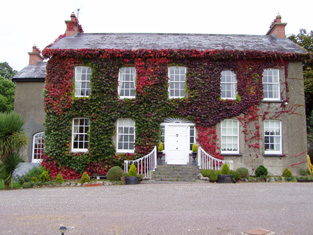
|
| Allowdale | A house valued at almost £12 in the mid 19th century, held by Daniel McCabe from the Earl of Egmont, now a ruin. | |
| Dysert | A house valued at £12 and held by Nicholas P. Leader in fee at the time of Griffith's Valuation. This house was still in Leader occupation in 1906. A house and farm are still extant at the site. | |
| Fort Grady | Located on the O'Grady, Viscount Guillamore estate, Fort Grady was valued at £14 in the mid 19th century and occupied by John O'Connell. In 1837 Lewis describes it as a farm house formerly the residence of the father of Viscount Guillamore. In 1814 it was occupied by Mr Daniel McAuliffe. In 1786 Wilson refers to it as "Knockbrack, the seat of Mr. Gredy". A house and farm are still extant at the site. | |
| Nashville/Rosnalee | This house was originally known as Nashville and was the home of the family of that name in the 18th century. Wilson refers to it as Nashville, the seat of Mr. Nash, in 1786. It passed by marriage to the Leader family. Nicholas P. Leader occupied the house in 1814. It was still known as Nashville in 1837 but is marked on the first Ordnance Survey map as Rosnalee. Valued at £51 at the time of Griffith's Valuation it was held by William Leader in fee and he had a flour mill nearby valued at £45. The Leaders still occupied this house in 1921. In 1943 the Irish Tourist Association Survey noted it as having been the chief seat of the Leaders, a two-storey spacious structure which was then unoccupied. It is no longer extant. | |
| Keale House | The seat of a branch of the Leader family in the 18th and 19th centuries, sold by them in the early 20th century. The buildings were valued at £22+ in the mid 19th century and the property was held by John Leader from Thomas G. French. The National Inventory of Architectural Heritage suggests the present house was built in 1834. It is still extant and well-maintained. |
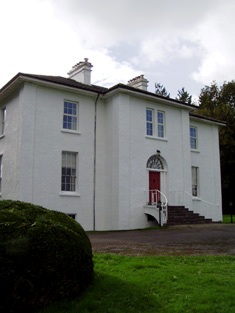
|
| Rossline House | John Noonan held this house valued at £14.15 shillings from Sir Edward Tierney in the mid 19th century. A house and farm are still extant at the site. | |
| Rossline Lodge | Hajba writes that this house was originally built as a hunting lodge for the Earls of Egmont. Patrick Keller held this house valued at £12.10 shillings from Sir Edward Tierney at the time of Griffith's Valuation. It is still occupied. | |
| Castle Park | At the time of Griffith's Valuation this house, valued at £41, was held by Sir Edward Tierney in fee. Still in use as a private residence, in 2014 it was offered for sale. |

|
| Park House | Occupied by Maurice Barry and held from Sir Edward Tierney in the mid 19th century when the buildings were valued at £12+. William F. S. Barry was the occupier in 1906. It is still extant. | |
| Park | A house valued at £18+ in the mid 19th century and held by Sir Edward Tierney in fee. A house is still extant at the site. | |
| Wood View | A house valued at £10+ in the mid 19th century, occupied by Denis McCartie who held it from John McCarthy. The residence of J. McCartie in 1837. In the Irish Tourist Association Survey of the 1940s it is referred to as the residence of Mr. Daly and "formerly the home of the McCarthy-O'Leary family, connected with Daniel O'Connell". The original house is no longer extant. | |
| Killeenleagh | No demesne was marked in this townland on the first Ordnance Survey map but a house valued at £15+ was situated there by the time of Griffith's Valuation. It was occupied by Richard O'Callaghan and held from the Earl of Listowel. | |
| Spring Grove | This house was the home of Arthur Bastable in 1814. This house was part of the Creagh estate for sale in July 1853, Christopher Carleton, "a lunatic", was the leasee. Unoccupied at the time of Griffith's Valuation when valued at £9.10 shillings. The representatives of Thomas Harris were the immediate lessors. A house is still extant at the site. | |
| Ardnageeha | Hajba writes that this house was built by Daniel McCartie, a Commissioner of Tithes for the parishes of Cullen and Drishane. The house valued at £12.10 shillings was occupied by his wife Anne McCartie at the time of Griffith's Valuation. The property was held from the Earl of Egmont. Daniel's only child Mary married John Maurice O'Connell, a grandson of Daniel O'Connell. The O'Connell lived at Ardnageeha until 1890 when they moved to Derragh House. The house is still extant though possibly not occupied. |

|
| Derragh | This house was the home of Denis McCartie in the first half of the 19th century. In the occupation of the Poor Law Guardians at the time of Griffith's Valuation when it was valued at £12+ and held from his widow Ellen McCartie. Later occupied by John and Mary O'Connell formerly of Ardnageeha. The house was demolished in the 1950s. | |
| Church Hill | Occupied by Charles McCarthy in 1814 and by Daniel McCartie in 1837. Mary McCartie occupied the house in the early 1850s holding it from Anne McCartie. It was then valued at £5.10 shillings. Hajba writes that the last McCartie to live at Church Hill was Richard. The property was sold to the Shine family in the late 19th century and there are only some ruined remains of the house. | |
| Duarrigle Castle | Originally a tower house of the O'Keeffe family, leased by Henry Wrixon to Thomas Holmes Justice who built a 'mock' castle in the early 19th century. Inherited by his son Thomas Holmes Justice medical doctor of Mallow. Sold in the Encumbered Estates' Court in 1851 and bought by Henry Chinnery Justice, who left it to his sister Mrs Wallis when he died in 1859. The castle is now a ruin but the gatelodge is occupied. |
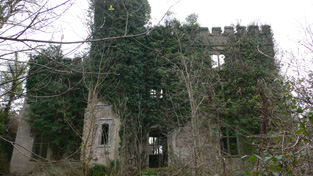
|
| Mount Justice | This was a home of the Justice family from at least the late 18th century. By the time of Griffith's Valuation the house was valued at £3.15 shillings and was occupied by John Bolton Justice who held it from Charles D. Purcell. Hajba writes that members of the Justice family continued to occupy the house until the 1920s. It is now demolished. | |
| Garrane House | This house is not marked on the first Ordnance Survey map. By the time of Griffith's Valuation however Henry Justice occupied a house valued at £11.10 shillings at Garrane West. He held the property from John C. Wallace [Wallis]. The home of members of the Twomey and O'Keeffe families in the 20th century and still occupied. | |
| Flintfield House | This house was a seat of the Chinnery family from the mid 18th to the mid 19th century. It was occupied by Barry Cotter in 1814 and by Denis O'Connell in 1837 and at the time of Griffith's Valuation. The buildings were valued at £18+ and the property was held from John Orpen. Home of the MacSweeneys in the 20th century. |
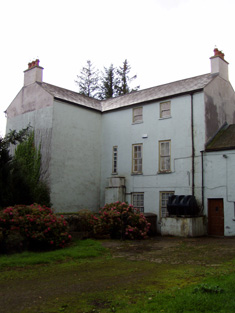
|
| Minehill | Home of a branch of the Wallis family in the early 19th century. Occupied by Denis McCarthy in 1814 and by John Cooke Wallis in 1837. By the time of Griffith's Valuation it was the residence of Francis Burton. The house was still home to the Burton family in the early 21st century. | |
| Rathroe | Hajba records a lease of Rathroe House from Sir Robert Deane to Denis McCarthy dated 1779. In 1837 another Denis McCarthy was occupying the house and he was also resident in the early 1850s when the house was held from the Reverend Nicholas Chinnery. The buildings were valued at £26.15 shillings. Hajba writes that the McCarthys continued to live in the house until it was sold in the 1930s to Con Meaney TD. The house is no longer extant. | |
| Coolemore | This was the residence of Herbert O'Donnell in 1837 and in the early 1850s. Located on the Wallis estate it was valued at £20. Hajba writes that O'Donnell was agent to the Wallis estate and that it was later the home of the Perry family. A house is still extant at this site. | |
| Drishane Castle | Originally a MacCarthy castle, granted to the Hollow Sword Blade Company at the end of the 17th century, it was acquired by Henry Wallis from county Waterford in the early decades of the 18th century. William Wallis built the house near the castle soon afterwards and it remained in Wallis possession until the early 20th century. In 1894 Slater noted it as the seat of Aubrey J Wallace [Wallis]. The Sisters of the Infant Jesus, a French order of teaching nuns, occupied the house for most of the 20th century. In 1944 the Irish Tourist Association Survey outlined a history of the castle and the sale to the nuns. The castle is still extant. |

|
| Coomlogane | A late 18th century house was built near the original building. In 1786 Wilson refers to it as the seat of Mr. O'Leary. This house became the home of the McCarthy-O'Learys for all the 19th century. In the mid 19th century it was valued at £38. John McCarthy O'Leary occupied the house in 1906. It was looted during the War of Independence and is now demolished. | |
| Tullig | Henry Leader of Tullig died in 1834 and the Leader interest in this property came to an end. James Nash (died 1849) of Rockfield, Kanturk and of Tullig House, Millstreet is recorded in ''Burke's Irish Family Records''. At the time of Griffith's Valuation Tullig, valued £20 was occupied by the Reverend Charles Mangan and held from Jonas Morris. |
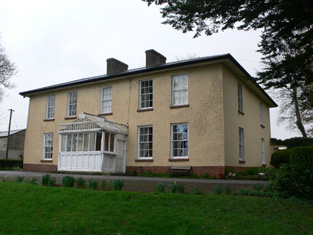
|
| Clonmeen House | Built in 1893 for Stephen Grehan and designed by George Ashlin. This house remained in the possession of the Grehan family until the 1970s. In the 1940s the Irish Tourist Association Survey noted it as the residence of Major Grehan. Late in the twentieth century it functioned as a hotel for some time but has now returned to private ownership. |

|
| Clonmeen Lodge | Hajba writes that this house was the home of Cornelius O'Callaghan in 1750. In 1786 Wilson refers to "Bantyre" as the seat of Mr. Callaghan. Viscount Lismore is recorded as proprietor of Clonmeen in 1814. At the time of Griffith's Valuation Clonmeen Lodge was occupied by George Grehan and held from Viscount Lismore. It was valued at £7+. The Grehans continued to use this house as a secondary residence while their main residence was in Dublin. In 1893 a much larger house, Clonmeen House, was built close to the lodge. In the 1940s the Irish Tourist Association Survey noted "The Lodge, Banteer" as the residence of Jerome O'Callaghan and stated that the house had originally been built by the Nash family as a fishing lodge. A building is still extant at the site. | |
| Springville | Originally owned by a family named Minton who sold the property to the Wises of Cork city in the 1840s. It was then leased to Charles Daly who occupied the house valued at £5 at the time of Griffith's Valuation. Grove White writes that Daly spent a large sum of money reconstructing the house. Later occupied by O'Briens and Bolsters, still extant and lived in. |

|
| Gortmore Cottage | At the time of Griffith's Valuation, Gortmore Cottage was occupied by Roger O'Callaghan, leasing from Reverend Phillip Townsend, when the house was valued at £11. In the 1940s the Irish Tourist Association Survey noted that the original house had burnt down in 1911 and a two-storey house was then occupying the site. |

